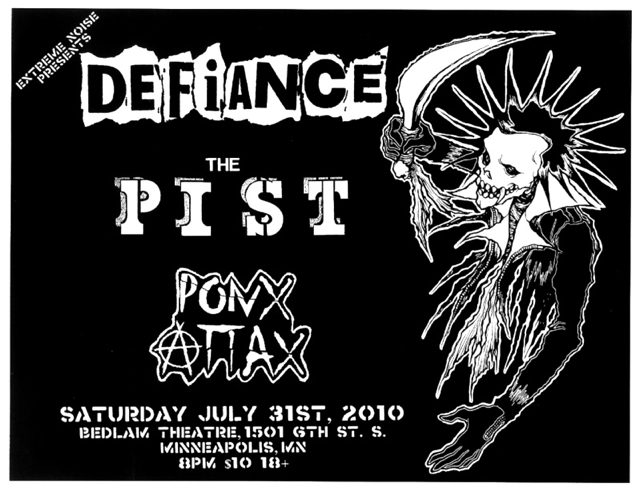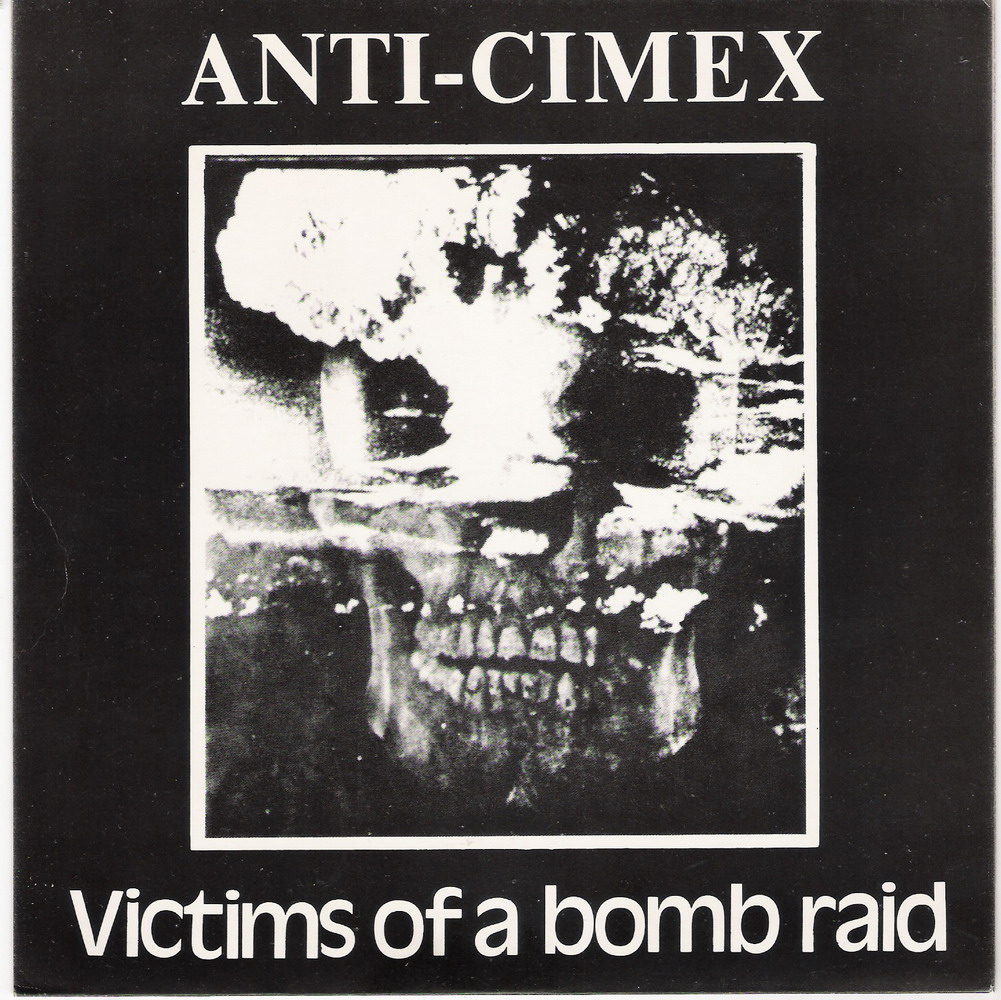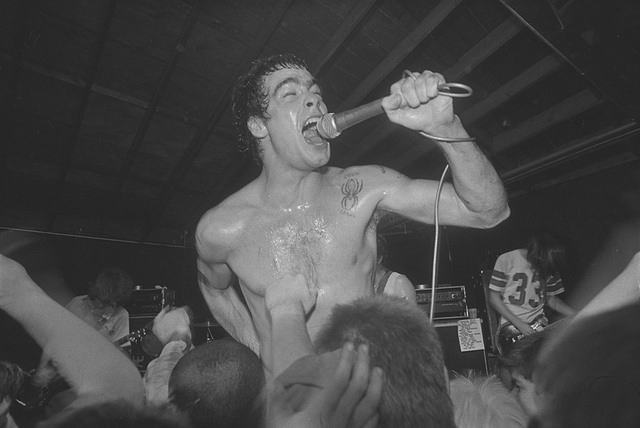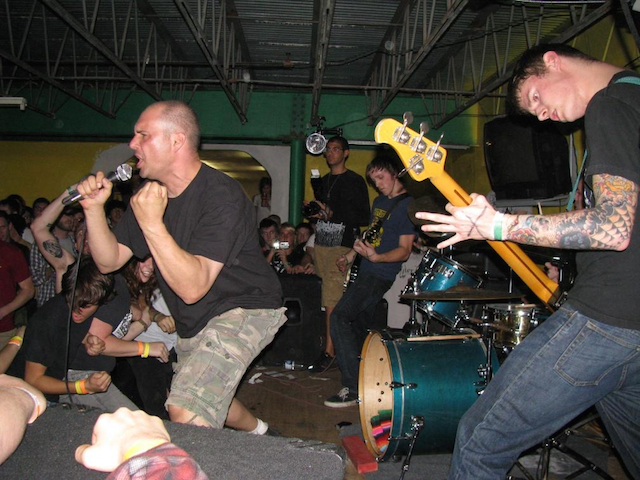One of the peculiarities of the early punk scene was the way that certain sounds became associated with certain towns. In mid-1980s, New York became famous for bands with a crunchy, metallic sound, such as Judge, Youth of Today, and the Cro-Mags. Although Chicago has produced a wide range of groups, it’s hard to dissociate the city from dark and angular sounding 1980s bands such as Naked Raygun, The Effigies, and Articles of Faith.
Over the last three decades, Los Angeles has produced a startlingly wide variety of punk groups, including such seminal acts as X and Black Flag. And yet there is also a strong and persistent association of the city with melodic punk bands such as D.I., The Vandals, and Social Distortion. Though Black Flag and X are far more influential, their sound is ironically considered less regionally specific than locals like the aformentioned Vandals.
Compared to LA, Portland, Oregon, a former railroad company town sitting astride the Willamette River, is not the most cited locale in the history of punk. Yet, since the early 1980s, Portland’s punk scene has shown a remarkable capacity to take in styles from far off places and integrate them into a distinctly local punk culture all its own. In fact, Portland has come to be seen as something of a mecca of the crust punk scene, not exactly the public radio-friendly alternative rock the city is best known for. That this is so is both a testament to the international cachet attached to this outgrowth of the second wave of punk in the United Kingdom, but also to the openness of artists in the local punk community to a diverse range of stylistic influences.
What is crust? Answers will vary depending on who you ask. However, the term first arose to describe a style of music and dress that arose in the UK in the early 1980s. The British punk scene, which had arisen in the heady days of The Sex Pistols and The Clash had faded. On the ground that it had prepared grew up a new scene centered around bands like Disorder, Chaos UK, The Varukers, and, most influentially, Discharge.
Formed in 1977 in Stoke-on-Trent, an unassuming industrial down in the East Midlands, Discharge created a sound and a style that continues to shape extreme music more than thirty years later. Their black leather jackets festooned with cone studs lent a new visual dimension to the hardcore scene. But it was their simple, hard charging music with its d-beat rhythms that would exert the most influence. It could be seen almost immediately in Scandinavia, where bands like Avskum from Sweden, and Kaaos from Finland, as well as a whole host of similar acts took up the gage that Discharge had thrown down.
The rise of the crust scene was in some respects a follow-on effect of the above-mentioned changes in British punk. After 1982, Discharge increasingly took a more overtly metallic direction, much to the dismay of their diehard fans. In part, this had to do with the debates that had been percolating within punk circles in the United Kingdom and North America, as to whether metallic influences were acceptable or constituted a degradation of the punk aesthetic. The moves by Discharge in this direction gave impetus to the acceptance of the fusion. It would have been even more influential if the band’s approach wasn’t compromised by its singer’s shift to clean-sounding, and sometimes falsetto vocals. Clearly, this was not the best way to promote stylistic synergy. As the 1980s progressed, the crossover synthesis nevertheless evolved. The end result was crust punk.
As a subgenre description, the term “crust” first arose in the mid-1980s. According to the punk historian Ian Glasper, the term first surfaced in 1986 in the title of a demo by the Newcastle upon Tyne hardcore band Hellbastard. The Ripper Crust demo has subsequently achieved legendary status, but at the time it was the only instance in a scene comprising bands like Sacrilege, Deviated Instinct, Amebix, and Extreme Noise Terror, and that would generate both crust and grindcore.
The influence of developments in the British hardcore scene were felt around the world, and not least in North America. In the mid-1980s, in the major cities of the United States, one still saw the heavily studded leather jackets and Doc Martens. But instead of Clash and UK Subs t-shirts, they were now Antisect and Amebix shirts. This might have struck some of the actual progenitors of the style as odd, given that (with a few exceptions) animal rights and veganism had caught on earlier and much more extensively in the UK than in the US. Still, the sights and sounds of the British music scene were once again crossing the Atlantic, and one of the most important toeholds that it acquired was in Portland, Oregon.
Portland was always a town with a bit of a reputation. In the 1980s, that reputation centered around alcohol and violence. Nothing in Portland better exemplified this than the flagship band in the scene: Poison Idea. Their frontman Jerry A. was the poster child for the rock and roll lifestyle. P.I’s sound was brash and aggressive. Their earlier releases, perhaps best exemplified by the Record Collectors Are Pretentious Assholes 12” (Fatal Erection, 1984,) evinced a style well within the bounds of American hardcore. But for all that, the breadth of stylistic influence operative in the Portland music scene can be judged from the cover of Record Collectors. Elements of P.I. guitarist Tom “Pig Champion” Roberts’s record collection are strewn across the floor, including such rareties as the Misfits Beware 10”, the Germs Beware 10”, the Germs Lexicon Devil 7”, Battalion of Saints’ Fighting Boys 12”, and the first Eater 7”.
Although Poison Idea were the scene’s most prominent act, the connection to the second wave of British punk was most clearly exemplified by Final Warning. Both in terms of music and appearance, Final Warning owed a debt to Discharge. From the simple, pounding rhythms of their songs, to the hint of chorus in the guitar that gives their riffing a slightly metallic tinge, Final Warning redeployed (without really imitating) Discharge’s style.
When Final Warning broke up in 1986, the synergy between punk and metal was coming to dominate the scene. Poison Idea released their first full LP, Kings of Punk, in 1986. While not fully crossing over, Kings had a sound that was more metal influenced than their previous material, and it was no accident that it come out on a record label (Pusmort) run by Septic Death frontman Brian “Pushead” Schroeder, one of the most avid promoters of punk/metal fusion in those days.
The late 1980s in Portland also saw the emergence of a burgeoning thrash metal scene. Leading the charge were Wehrmacht, whose Shark Attack LP (New Renaissance, 1987) featured blistering thrash and recordings of the band vomiting. In the booze-fueled Portland underground scene, this made perfect sense.
Contrary to what one might conclude from the name, Wehrmacht were certainly not associated with the political right. This was just as well. Although Portland still retained something of its hippie vibe, by the early 1980s it was home to an small but influential skinhead scene. As the decade went on, this particular set, prone to stupidity and violence at the best of times, moved to open espousal of white power politics. In November 1988, members of East Side White Pride murdered an Ethiopian immigrant, Mulugeta Seraw, on the street in southeast Portland. The murder shocked the city and brought intense scrutiny to an underground scene that had to that point been very much outside of civic consciousness.
As the 1980s came to a close, the punk scene in Portland seemed very much at loose ends. Poison Idea were still prominent, but after more than a decade of destructive antics it was increasingly difficult to take them seriously. Wehrmacht broke up in 1989, with two members going on to form Spazztic Blurr and another joining Cryptic Slaughter. But the waning days of the 1980s had also seen the early movements in the rise of a new scene, one which took its stylistic and sartorial cues from the British crust scene that had blossomed a few years before. Bands like Resist, The Unamused, The Deprived evinced both the leather and studs style and the anarchist politics of the post-Discharge scene across the Atlantic.
Resist’s 1991 debut LP, The Solution…Revolution, exemplified both the musical debt to British hardcore scene, but also a more developed commitment to anarchist politics. Resist’s songs dealt with political repression (“Submit and Obey,”) nationalism (“Red, White, and Blue,”) and sexual equality (“Homophobia,”) in ways that were explicitly and unapologetically politically radical.
This was a distinct change from the earlier era of Portland punk, in which bands tended to be either vaguely leftist or completely apolitical, and there was a pronounced streak of redneckism (rising to the level of actual political conservatism) among a prominent segment of the fans. For example, Poison Idea’s “Ugly American” opens with the words “Listen Nazi, never again,” but this was far and away the closest they ever got to a political statement. This change in the zeitgeist could hardly be better illustrated by the fact that one contributing factor in the breakup of The Unamused was that drummer Craig Rosebraugh wanted to concentrate more on political activism. He would later become the spokesman for the Earth Liberation Front and be subpoenaed to testify before Congress (where he took the Fifth in response to 54 of 56 questions he was asked.)
Stil, it should be noted that the music of these bands was, in many respects, similar to street punk bands of the second wave in the UK, than to what one might call mainstream crust. Defiance, formed in 1993 from members of The Unamused, The Deprived, and Resist, had a sound that had more in common with British band The Partisans than with Deviated Instinct. What might be referred to as the proper crust scene didn’t get going until the mid-1990s.
When it did, it bore clear marks of international influences. Bands like Atrocious Madness and Detestation took their inspiration from Japanese hardcore (with the latter band taking their name from an album title by the legendary Tokyo hardcore band GISM.)
Other Portland bands of that period, such as Masskontroll, Aftermath, Warmachine, and Axiom took inspiration from classic Swedish d-beat bands such as Anti Cimex and Crude SS.
Within this matrix of influence, the crust scene in Portland took shape.
By the lat 1990s, Portland’s reputation had changed dramatically. It was still a hard drinking town, but now this was coupled with the perception that it was a place where dark, metal-tinged music could get a hearing, one in which there was a significant autonomist scene to boot. The late ’90s also saw the scene leavened in important ways by an influx of musicians from other cities who saw in Portland a sympathetic environment in which to ply their trade. One source in particular stands out: Tennessee. After the breakup of Memphis dark crust stalwarts His Hero Is Gone, three of the former members formed Tragedy and moved to Portland in the early 2000s.
When Nashville’s From Ashes Rise relocated there as well, the darkly melodic, guitar-heavy sound that these bands pioneered became well ensconced in Portland’s stylistic repertoire.
The Portland scene continues to generate homegrown talent as well, with bands like Hellshock continuing the tradition of melding international punk styles into a sound that seems specific to the place.
Connections have been maintained with the older generations of Portland punk as well. Until his untimely death in March, Final Warning vet Jeff Paul was fronting Trauma, one of the most promising and uncompromising up and coming acts in town.
The hallmark of the Portland punk scene, both in its crust and non-crust elements, has been a willingness to integrate stylistic influences and thereby to create something which is more than a mere copy or homage to other styles. It is easy to forget in this current era of porous media that this tendency arose at a time when it was much more difficult to find out what was going on in London, to say nothing of Stockholm, or Tampere, or Tokyo, than it is today. Perhaps that most remarkable thing about the Portland crust scene is its roots in a kind of intellectual and artistic curiosity strong enough to overcome the forces of distance and apathy.
Photograph courtesy of Bedlam Theatre. Published under a Creative Commons license.





